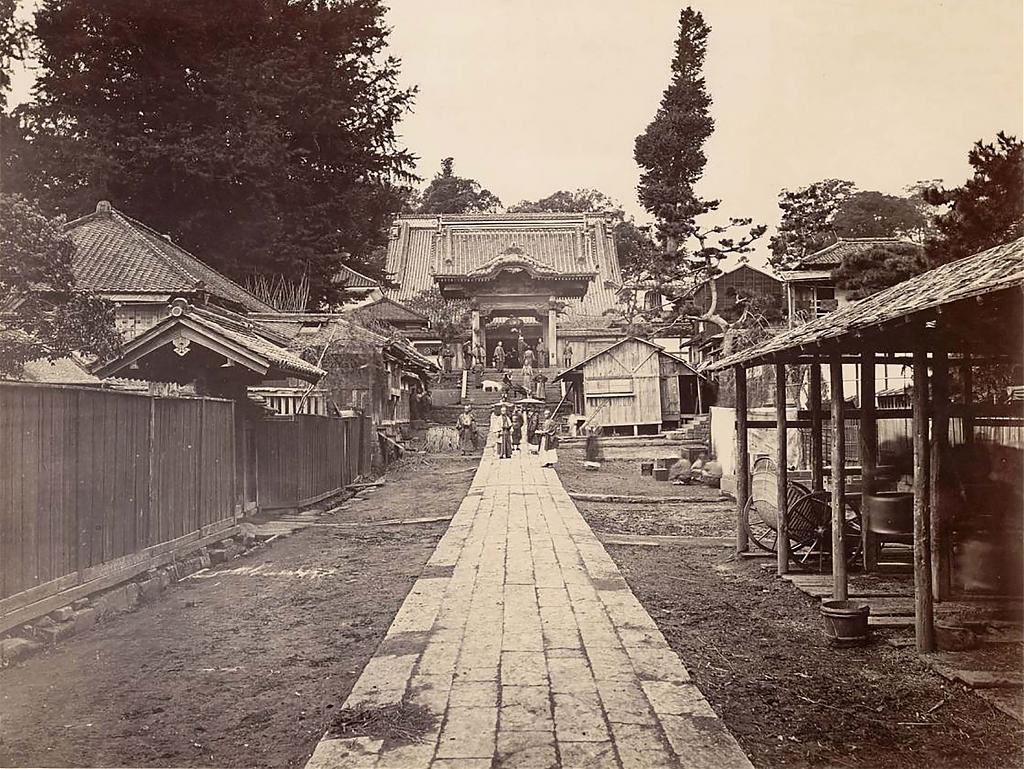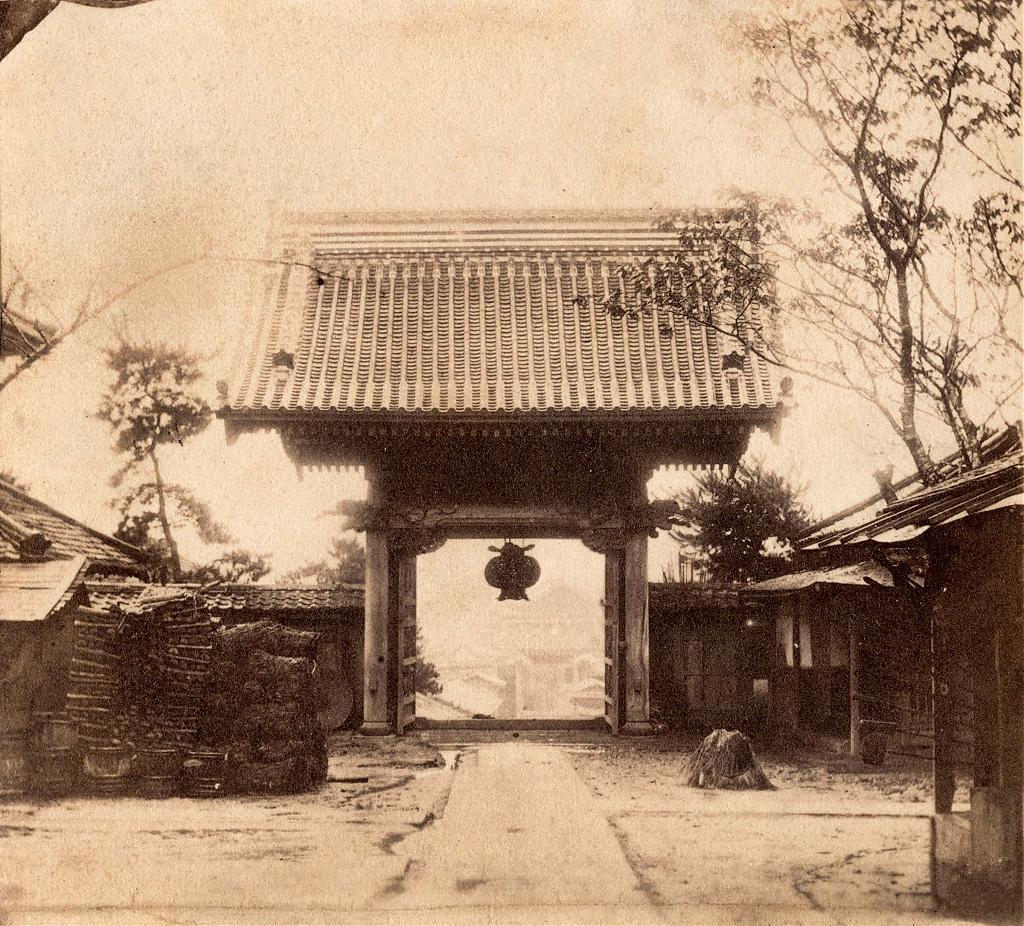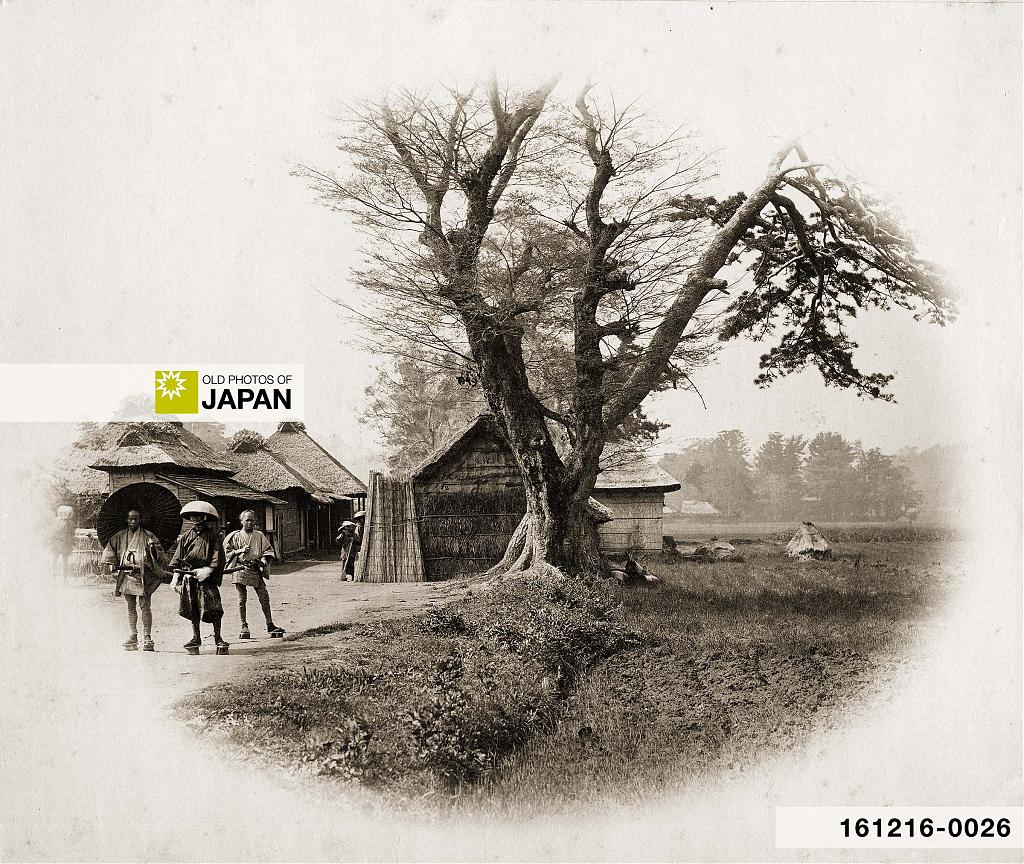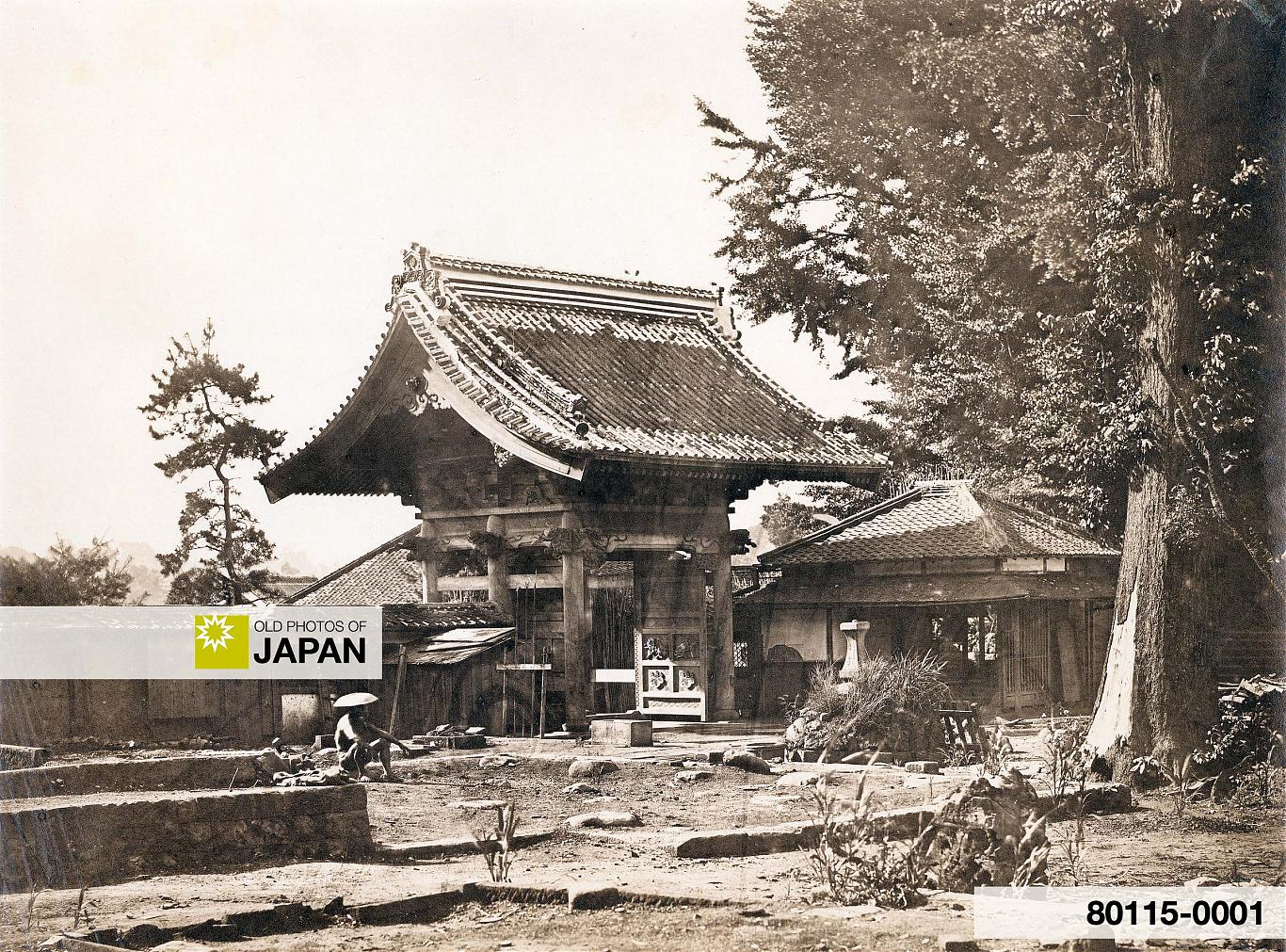I almost sold this print because it seemed insignificant. Thankfully, a book by Dutch historian Herman J. Moeshart helped me realize it is an extremely rare and important historical document.
This is one of those rare prints that seem totally insignificant, but which are in effect extremely important and valuable. What you see here in front of this magnificent temple gate, is a dramatic episode in the early stages of international relations between Japan and the United States.
These are the ruins of the American Legation at the Zenpukuji temple (善福寺) in Azabu, Edo (present-day Tokyo). In 1859 (Ansei 6), this Buddhist temple became the home of the first American legation in Edo—actually the first one in Japan.
On May 24, 1863 (Bunkyū 3), the legation and several other temple buildings burned down, now generally described as arson by samurai of the Mito Domain. The U.S. Minister to Japan at the time was Robert Hewson Pruyn (1815–1882), successor of Consul Townsend Harris (1804–1878), who negotiated the first trade treaty between the two nations.
Like Harris, Pruyn was determined to maintain the legation in Edo. Echoing his predecessor, he argued that if he left, foreign envoys would never be able to return. Undeterred, he moved into smaller rooms at the complex.
However, only a week later, on May 31, Pruyn was suddenly warned by a Japanese government official that a conspiracy had been discovered. An attack on the legation was expected that very night. Pruyn immediately moved to Yokohama.1
The other foreign legations had already moved to Yokohama after the Dutch-American interpreter of the American Legation, Henry Heusken, had been assassinated by samurai of the Satsuma Domain in January 1861, followed by violent attacks on the British Legation in July of that year, and 1862.
Pruyn’s departure marked the temporary end of the foreign diplomatic presence in Edo, and the start of even greater upheaval.

The fire was said to have been accidental, but in his letters to Secretary of State William Henry Seward (1801–1872), Pruyn expressed his suspicions that it had been arson.2 He could however not provide any proof.
Soon after the fire, the foreign envoys were told that the Shogun had been ordered by the emperor to expel all foreigners from Japan. An extremely tense and trying period ensued. There were expectations of war between Japan and the foreign powers. Many Japanese inhabitants fled Yokohama.
In a way, this photo of an imposing Japanese gate affording entry to the desolate empty space where the American legation used to be, perfectly symbolizes this difficult period during Japan’s fledgling foreign relations with the outside world.

Pruyn described the fire in two letters to his wife. Here is an excerpt from the second, more organized, letter:3
The fire broke out at 2 A.M. of Sunday in or near the kitchen. I was aroused by Onigero whose presence was very opportune as otherwise the presence a moment afterwards of more than twenty Yakoneens each with a lantern would have been somewhat startling. I rose and dressed with more deliberation than I should exercise again after my experimental knowledge of the rapidity with which Japanese homes are devoured by the flames. I placed my watch and a small pistol lying under my pillow in my pockets. Placed a large Colt Navy revolver in another pocket, went to the adjoining room and took out [and] buckled on my sword, then took from the table a flask of powder, some fixed ammunition [and] caps [and] then pointed out my trunk to be removed as also a bureau. Meanwhile I had of course called Bertie who was in one of the adjoining room[s]. In the parlour a large number of pieces of silk were hanging. These I directed to be rolled up; but the Yakoneens more experienced than myself at once cut the ropes [and] began to bundle up the silks, I then being unable to make them understand me, started from the room knowing well they would all follow me. I went to the large express trunks [and] pointed to them. These were carried on the parlour [and] filled with silks. The trunk was saved; the other burned. I then started back my Yakonins rushing after me [and] jabbering Japanese which must have been very poor as I could not understand it. I should have said I had white dressing sent for Mr. Portman. He had arrived and we had saved the papers [and] given directions about books etc. Finally hearing Berties cries Father! Father! I had learned from him that what the Yakonins were saying to me was not that they wished me to point out what I wished saved but to save me as there was danger of the roof coming down. Had I known this earlier probably more articles would have been saved; as I kept them dodging briskly after me. As soon as the fire reached the hall it went on with the rapidity of a race horse. You must bear in mind all our castings were of paper. The division between the bed rooms [and] office [and] the hall between my room and the dressing room were made of translucent paper forming small panes pasted against the most beautifully made [and] lightest woodwork you can imagine—all joined thus [small grid-like sketch inserted into letter]. The other partitions were of paper thick [and] ornamented like our wall paper. You can readily imagine such fine walls would not long obstruct the progress of the flames. I had however misunderstood Onigero who had rushed in saying Minister it is all over—I thought he meant the fire was out, instead of that he intended “it was all over the premises.” In 15 minutes by the watch the entire building over 200 feet long was in flames.



Times of Danger
After Japan opened up to the outside world in the 1850s, it slowly turned into a very dangerous place for both foreigners and Japanese. Assassinations and battles between government troops and those of daimyō (feudal lords) gradually became the order of the day. Three domains were at the center of this struggle: Satsuma, Chōshū, and Mito.
Mito Domain played an especially influential role. Over the centuries, Mito had developed a reputation as a center for intellectual thought, which gave great legitimacy to the ideas promoted by Mito School (水戸学, Mito-gaku) scholars. Their ideas of isolationism, nativism, and reverence of the emperor therefore profoundly influenced thought in Japan.
So, when these scholars started emphasizing anti-Western sentiment, and embracing the political slogan “Revere the emperor and expel the barbarians” (尊皇攘夷, sonnō jōi), while arguing that the Tokugawa Shogunate was responsible for Japan’s weak economy and defense, it spread widely.

Many histories of this period describe a clear cut fight between the forces of Satsuma and Chōshū, who supported the emperor in Kyoto, with the ruling Shogunate, based in Edo. But in reality the situation was far more complex. Satsuma and Chōshū were actually at each other’s throats before the diplomacy of activist samurai Sakamoto Ryōma (坂本龍馬, 1836–1867), who advocated an independent and democratic Japan without feudalism, brought these two domains together.
There was fierce rivalry between other domains as well. It was not just Japanese samurai attacking foreigners, but samurai killing each other. Especially in Kyoto, where Sakamoto Ryōma himself was assassinated on December 10, 1867 (Keiō 3).
In his autobiography, Japanese educator and visionary Yukichi Fukuzawa (福澤 諭吉, 1835–1901) wrote a whole chapter about his many years of fear of assassination.4 Here is an excerpt:
I think I have made it clear that I never intended to make enemies. But in an age when anti-foreign sentiment was running high, it was unavoidable that in my position as an advocate of open intercourse and free adoption of Western culture, I should make some adversaries. It is not too much to have enemies who attack by means of words and epithets. But to have enemies who would resort to violent means is a different matter. Nothing can be worse, more unsettling, more generally fearful, than this shadow of assassination. No one without the actual experience can really imagine it. It is something indescribable by word or by any artifice of the writing brush. When there is some physical ailment or some definite soreness in the body, one can describe it to his wife or friend, but in regard to assassination, one cannot ask for sympathy even from those nearest him, for when told, they would worry about it even more than the one in immediate danger, and their anxiety would not relieve the situation in any way. I was not guilty of any crime, and it was no shame to be singled out by the ruffians, but feeling that there was no use in communicating an unpleasant possibility, I bore the anxiety by myself. Many a fearful moment have I come through, often frightened by the lonely “sound of the wind” or the sudden “cry of the crane.” It was somewhat like the present scare of the epidemic of hydrophobia when people are frightened by all good dogs because there are some mad dogs running loose. I suspected nearly every man on the street. The house which used to be my residence in the early years of Meiji still stands on the right hand side of the gateway to our grounds. When I was having it built, I ordered the carpenter to make the floor a little higher than usual and to lay a trap door in one of the closets. This was to be my secret means of escape in case I should be suddenly visited by the ruffians. I think the trap door is there yet, and so far as I know, no one knows of it, for I did not tell the carpenters what it was for and I did not explain such an unpleasant contraption to my family It was an unnecessary worry I had to bear alone. To recount the history of assassination since the beginning of our foreign intercourse—in the beginning, people simply hated the foreigners because all foreigners were “impure” men who should not be permitted to tread the sacred soil of Japan. Among these haters of foreigners, the samurai were the most daring and having their two swords conveniently at their sides, some of the younger and less restrained of these would spring on the “red-haired outlanders” in the dark. Still there was no reason for them to turn on the subjects of Japan, and so the students of foreign culture were yet safe from attack. While studying in Osaka, and even after coming to Yedo to teach, I had no feeling of danger for several years. For instance, when I heard of an attack on a Russian in Yokohama soon after the opening of the port, I was merely surprised by the cruel incident, but I felt no personal concern about it. Very quickly, however, the hatred of foreigners went through a tremendous development. It became more systematized, the objectives came to include many more persons, and the methods of slaughter became more refined. Moreover, political design was added to it and since the assassination of Chancellor li in 1860, the world seemed to become tense with bloody premonitions in the air. Tezuka Ritsuzo and Tojo Reizo were attacked by the Choshu clansmen for the simple reason that they were scholars of foreign affairs. Hanawa Jiro, a scholar of national literature, had his head cut off by an unknown man because of his sympathy for foreign culture. And the stores dealing in foreign goods were attacked for no other reason than that they sold foreign commodities which “caused loss’‘ to the country. Here then was the beginning of the national movement, “Honor the Emperor and Expel the Foreigners.” It was claimed that the Shogun was not prompt enough in carrying out the desires of the imperial court which had decreed the expulsion of all foreigners without exception. From this, it was argued that the Shogun was disobedient, was disrespecting the great doctrine of the land, and moreover was catering to foreign aggressiveness. Following this train of argument, it was but a step to calling all scholars of foreign culture traitors. And now we had to be careful. Especially when I heard of the attack on my friends and colleagues, Tojo and Tezuka, I knew that the hands of the assassins were not far from my door. Actually I was to go through some very narrow escapes. The period from the Bunkyu era to the sixth or seventh year of Meiji—some twelve or thirteen years—was for me the most dangerous. I never ventured out of my house in the evenings during that period. When obliged to travel, I went under an assumed name, not daring to put my real name even on my baggage. I seemed continually like a man eloping under cover or a thief escaping detection.

Below are a few individual assassinations that especially frightened the foreign community during the years after the opening of Japanese ports to foreign trade.5
| Year | Incident |
|---|---|
| 1859 | August 25: Russian naval officer Roman Samoilovich Mofet and sailors Sokolov and Korol'kov are attacked while shopping in Yokohama. Mofet and Sokolov are killed, Korol'kov is wounded. |
| 1859 | November: A Chinese servant of consul for France José Loureiro is killed while running an errant in Yokohama. |
| 1860 | January: Denkichi Kobayashi, the Japanese interpreter of British diplomat Rutherford Alcock, is stabbed to death at the English legation in Edo. |
| 1860 | February 26: Dutch merchant captains Wessel de Vos and Jasper Nanning Dekker are slaughtered on the main street of Yokohama while on their way to do some shopping. |
| 1860 | March 24: Tairō Ii Naosuke is cut down by rōnin samurai of the Mito and Satsuma domains near the Sakuradamon gate of Edo Castle. |
| 1861 | January 15: The Dutch-American interpreter for American Consul Townsend Harris, Henry Heusken, is ambushed in Edo. |
| 1862 | September 14: British merchant Charles Lennox Richardson is killed at the village of Namamugi, near Kawasaki, after failing to dismount when the regent of Satsuma Domain passes by. Two companions are severely wounded. Known as the Namamugi Incident it leads to the Bombardment of Kagoshima in August 1863. |
| 1863 | October 13: French Lieutenant Henri Camus, an officer attached to the French Legation, is pulled of his horse and murdered by three samurai at the village of Idogaya near Yokohama. |
| 1864 | November 21: British officers Major George Walter Baldwin and Lieutenant Robert Nichols Bird are murdered while on a visit to Kamakura. |

About the Photograph
Celebrated Italian–British photographer Felice Beato photographed the scene of the burned down legation in August of 1863, some three months after the fire had taken place. As far as I know this is the only existing photograph of the burned down legation. It is not the only print, but I don’t believe there are many.
The print is amazingly well-preserved, as you can see when you compare it with the prints of the legation which the Albany Institute of History & Art Library kindly made available to me (shown above). When the print of the burned down legation first came into my hands I did not imagine that it had been photographed as early as 1863, only a few years after commercial photography was first introduced to Japan.
As you can imagine, I am deeply grateful to Dutch historian Herman J. Moeshart.
Notes
1 The National Archives in Washington, DC. 188362921, Despatches from U.S. Ministers to Japan, 1855-1906: Feb. 7, 1862 – Dec. 31, 1863, 413–416.
2 ibid. 468–474.
3 Albany Institute of History & Art Library, CH532 Box 2 F 15.
4 Kiyooka, Aichi (1972). The Autobiography of Yukichi Fukuzawa. New York: Schocken Books, 225–228.
5 Sources for data in table:
- Russian sailors: Lensen, George Alexander (June 1954). Russians in Japan, 1858-1859, The University of Chicago Press, The Journal of Modern History Vol. 26, No. 2, pp. 162-173.
- Chinese servant: The London and China Telegraph, VOL VII, No. 192, Tuesday, November 28, 1865, pp. 609.
- Dutch captains: Moeshart, H.J. (2018). Dirk de Graeff and the Opening of Japan 1857-1869. Amsterdam/Berlin: Batavian Lion International, 95.
- Henri Camus: Polak, Christian (2012). Quelques souvenirs d’il y a 50 ans (1861-1871). France Japon Éco 131 Été 2012, pp. 57. Retrieved on 2022-04-08. | Bennett, Terry (1996). Early Japanese Images. Vermont, Tokyo: Charles E. Tuttle Company, 142.
- Baldwin and Bird: Massachusetts Institute of Technology: Visualizing Cultures. Felice Beato’s Japan: Places. Retrieved on 2022-04-08.
Published
Updated
Reader Supported
Old Photos of Japan aims to be your personal museum for Japan's visual heritage and to bring the experiences of everyday life in old Japan to you.
To enhance our understanding of Japanese culture and society I track down, acquire, archive, and research images of everyday life, and give them context.
I share what I have found for free on this site, without ads or selling your data.
Your support helps me to continue doing so, and ensures that this exceptional visual heritage will not be lost and forgotten.
Thank you,
Kjeld Duits
Reference for Citations
Duits, Kjeld (). 1863 Tokyo: Ruins of the American Legation, OLD PHOTOS of JAPAN. Retrieved on December 12, 2025 (GMT) from https://www.oldphotosjapan.com/photos/894/ruins-of-the-american-legation-zenpukuji-edo-vintage-photo




glennis
a great and focused history lesson that tells us a lot about the culture of the time as well. You know I would be interested in the packing up of the silks! My next walk through the port area of Yokohama I will be reminded of this violent period in that area. Fascinating!
#000726 ·
Kjeld
@glennis: I wonder if the silks survived the rough handling during the fire. In his first letter, Pruyn wrote that many of the items were thrown in the pond to protect them from the flames, including the books and even boxes with paper money… As the samurai were familiar with silk, I would like to think they did not throw these in the pond as well!
#000727 ·
Kristin Newton
This is fascinating! I used to have an art school right behind that temple and walked by it everyday. There is a magnificent old ginko tree, said to be at least 800 years old. I didn’t believe in ghosts before, but some little kids at my school could see them. One boy even drew a picture of a man he saw walking down the hall. I could hear footsteps upstairs at night, even though no one was there. Once when I was locking up at night, I was pushed from behind an fell against a wall…but no one was there. I was glad to leave that place as we had a lot of trouble there. Those angry samurai must still be hovering around.
#000754 ·
Kjeld (Author)
@Kristin Newton: What an interesting backstory! I know the tree that you mention. It is indeed magnificent.
Did you enter the modern temple building? It has a small museum for the history of the temple.
#000755 ·